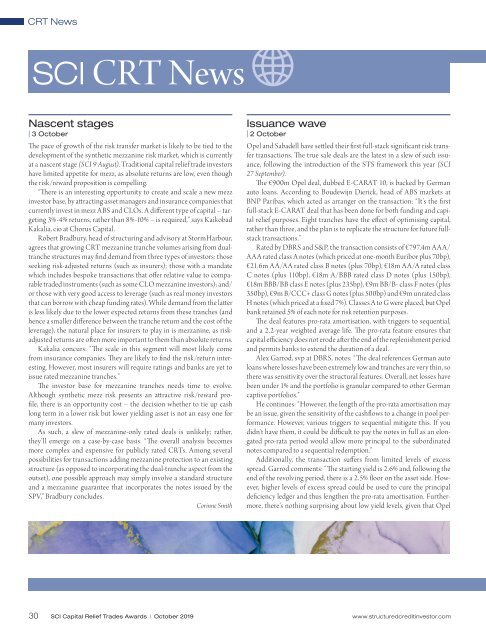SCI CRT Awards Issue Oct 19
You also want an ePaper? Increase the reach of your titles
YUMPU automatically turns print PDFs into web optimized ePapers that Google loves.
<strong>CRT</strong> News<br />
<strong>SCI</strong> <strong>CRT</strong> News<br />
Nascent stages<br />
| 3 <strong>Oct</strong>ober<br />
The pace of growth of the risk transfer market is likely to be tied to the<br />
development of the synthetic mezzanine risk market, which is currently<br />
at a nascent stage (<strong>SCI</strong> 9 August). Traditional capital relief trade investors<br />
have limited appetite for mezz, as absolute returns are low, even though<br />
the risk/reward proposition is compelling.<br />
“There is an interesting opportunity to create and scale a new mezz<br />
investor base, by attracting asset managers and insurance companies that<br />
currently invest in mezz ABS and CLOs. A different type of capital – targeting<br />
3%-4% returns, rather than 8%-10% – is required,” says Kaikobad<br />
Kakalia, cio at Chorus Capital.<br />
Robert Bradbury, head of structuring and advisory at StormHarbour,<br />
agrees that growing <strong>CRT</strong> mezzanine tranche volumes arising from dualtranche<br />
structures may find demand from three types of investors: those<br />
seeking risk-adjusted returns (such as insurers); those with a mandate<br />
which includes bespoke transactions that offer relative value to comparable<br />
traded instruments (such as some CLO mezzanine investors); and/<br />
or those with very good access to leverage (such as real money investors<br />
that can borrow with cheap funding rates). While demand from the latter<br />
is less likely due to the lower expected returns from these tranches (and<br />
hence a smaller difference between the tranche return and the cost of the<br />
leverage), the natural place for insurers to play in is mezzanine, as riskadjusted<br />
returns are often more important to them than absolute returns.<br />
Kakalia concurs: “The scale in this segment will most likely come<br />
from insurance companies. They are likely to find the risk/return interesting.<br />
However, most insurers will require ratings and banks are yet to<br />
issue rated mezzanine tranches.”<br />
The investor base for mezzanine tranches needs time to evolve.<br />
Although synthetic mezz risk presents an attractive risk/reward profile,<br />
there is an opportunity cost – the decision whether to tie up cash<br />
long term in a lower risk but lower yielding asset is not an easy one for<br />
many investors.<br />
As such, a slew of mezzanine-only rated deals is unlikely; rather,<br />
they’ll emerge on a case-by-case basis. “The overall analysis becomes<br />
more complex and expensive for publicly rated <strong>CRT</strong>s. Among several<br />
possibilities for transactions adding mezzanine protection to an existing<br />
structure (as opposed to incorporating the dual-tranche aspect from the<br />
outset), one possible approach may simply involve a standard structure<br />
and a mezzanine guarantee that incorporates the notes issued by the<br />
SPV,” Bradbury concludes.<br />
Corinne Smith<br />
Issuance wave<br />
| 2 <strong>Oct</strong>ober<br />
Opel and Sabadell have settled their first full-stack significant risk transfer<br />
transactions. The true sale deals are the latest in a slew of such issuance,<br />
following the introduction of the STS framework this year (<strong>SCI</strong><br />
27 September).<br />
The €900m Opel deal, dubbed E-CARAT 10, is backed by German<br />
auto loans. According to Boudewijn Dierick, head of ABS markets at<br />
BNP Paribas, which acted as arranger on the transaction: “It’s the first<br />
full-stack E-CARAT deal that has been done for both funding and capital<br />
relief purposes. Eight tranches have the effect of optimising capital,<br />
rather than three, and the plan is to replicate the structure for future fullstack<br />
transactions.”<br />
Rated by DBRS and S&P, the transaction consists of €797.4m A A A/<br />
A A A rated class A notes (which priced at one-month Euribor plus 70bp),<br />
€21.6m A A/A A rated class B notes (plus 70bp), €18m A A/A rated class<br />
C notes (plus 110bp), €18m A/BBB rated class D notes (plus 150bp),<br />
€18m BBB/BB class E notes (plus 235bp), €9m BB/B- class F notes (plus<br />
350bp), €9m B/CCC+ class G notes (plus 500bp) and €9m unrated class<br />
H notes (which priced at a fixed 7%). Classes A to G were placed, but Opel<br />
bank retained 5% of each note for risk retention purposes.<br />
The deal features pro-rata amortisation, with triggers to sequential,<br />
and a 2.2-year weighted average life. The pro-rata feature ensures that<br />
capital efficiency does not erode after the end of the replenishment period<br />
and permits banks to extend the duration of a deal.<br />
Alex Garrod, svp at DBRS, notes: “The deal references German auto<br />
loans where losses have been extremely low and tranches are very thin, so<br />
there was sensitivity over the structural features. Overall, net losses have<br />
been under 1% and the portfolio is granular compared to other German<br />
captive portfolios.”<br />
He continues: “However, the length of the pro-rata amortisation may<br />
be an issue, given the sensitivity of the cashflows to a change in pool performance.<br />
However, various triggers to sequential mitigate this. If you<br />
didn’t have them, it could be difficult to pay the notes in full as an elongated<br />
pro-rata period would allow more principal to the subordinated<br />
notes compared to a sequential redemption.”<br />
Additionally, the transaction suffers from limited levels of excess<br />
spread. Garrod comments: “The starting yield is 2.6% and, following the<br />
end of the revolving period, there is a 2.5% floor on the asset side. However,<br />
higher levels of excess spread could be used to cure the principal<br />
deficiency ledger and thus lengthen the pro-rata amortisation. Furthermore,<br />
there’s nothing surprising about low yield levels, given that Opel<br />
30 <strong>SCI</strong> Capital Relief Trades <strong>Awards</strong> | <strong>Oct</strong>ober 20<strong>19</strong> www.structuredcreditinvestor.com




